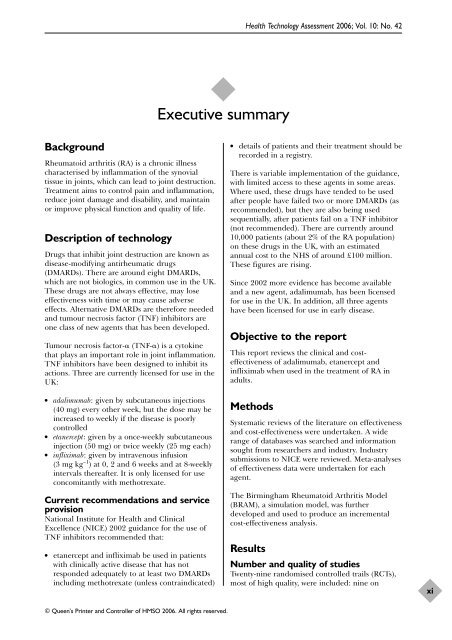A systematic review of the effectiveness of adalimumab
A systematic review of the effectiveness of adalimumab
A systematic review of the effectiveness of adalimumab
Create successful ePaper yourself
Turn your PDF publications into a flip-book with our unique Google optimized e-Paper software.
Background<br />
Rheumatoid arthritis (RA) is a chronic illness<br />
characterised by inflammation <strong>of</strong> <strong>the</strong> synovial<br />
tissue in joints, which can lead to joint destruction.<br />
Treatment aims to control pain and inflammation,<br />
reduce joint damage and disability, and maintain<br />
or improve physical function and quality <strong>of</strong> life.<br />
Description <strong>of</strong> technology<br />
Drugs that inhibit joint destruction are known as<br />
disease-modifying antirheumatic drugs<br />
(DMARDs). There are around eight DMARDs,<br />
which are not biologics, in common use in <strong>the</strong> UK.<br />
These drugs are not always effective, may lose<br />
<strong>effectiveness</strong> with time or may cause adverse<br />
effects. Alternative DMARDs are <strong>the</strong>refore needed<br />
and tumour necrosis factor (TNF) inhibitors are<br />
one class <strong>of</strong> new agents that has been developed.<br />
Tumour necrosis factor- (TNF-) is a cytokine<br />
that plays an important role in joint inflammation.<br />
TNF inhibitors have been designed to inhibit its<br />
actions. Three are currently licensed for use in <strong>the</strong><br />
UK:<br />
● <strong>adalimumab</strong>: given by subcutaneous injections<br />
(40 mg) every o<strong>the</strong>r week, but <strong>the</strong> dose may be<br />
increased to weekly if <strong>the</strong> disease is poorly<br />
controlled<br />
● etanercept: given by a once-weekly subcutaneous<br />
injection (50 mg) or twice weekly (25 mg each)<br />
● infliximab: given by intravenous infusion<br />
(3 mg kg –1 ) at 0, 2 and 6 weeks and at 8-weekly<br />
intervals <strong>the</strong>reafter. It is only licensed for use<br />
concomitantly with methotrexate.<br />
Current recommendations and service<br />
provision<br />
National Institute for Health and Clinical<br />
Excellence (NICE) 2002 guidance for <strong>the</strong> use <strong>of</strong><br />
TNF inhibitors recommended that:<br />
● etanercept and infliximab be used in patients<br />
with clinically active disease that has not<br />
responded adequately to at least two DMARDs<br />
including methotrexate (unless contraindicated)<br />
Executive summary<br />
© Queen’s Printer and Controller <strong>of</strong> HMSO 2006. All rights reserved.<br />
Health Technology Assessment 2006; Vol. 10: No. 42<br />
● details <strong>of</strong> patients and <strong>the</strong>ir treatment should be<br />
recorded in a registry.<br />
There is variable implementation <strong>of</strong> <strong>the</strong> guidance,<br />
with limited access to <strong>the</strong>se agents in some areas.<br />
Where used, <strong>the</strong>se drugs have tended to be used<br />
after people have failed two or more DMARDs (as<br />
recommended), but <strong>the</strong>y are also being used<br />
sequentially, after patients fail on a TNF inhibitor<br />
(not recommended). There are currently around<br />
10,000 patients (about 2% <strong>of</strong> <strong>the</strong> RA population)<br />
on <strong>the</strong>se drugs in <strong>the</strong> UK, with an estimated<br />
annual cost to <strong>the</strong> NHS <strong>of</strong> around £100 million.<br />
These figures are rising.<br />
Since 2002 more evidence has become available<br />
and a new agent, <strong>adalimumab</strong>, has been licensed<br />
for use in <strong>the</strong> UK. In addition, all three agents<br />
have been licensed for use in early disease.<br />
Objective to <strong>the</strong> report<br />
This report <strong>review</strong>s <strong>the</strong> clinical and cost<strong>effectiveness</strong><br />
<strong>of</strong> <strong>adalimumab</strong>, etanercept and<br />
infliximab when used in <strong>the</strong> treatment <strong>of</strong> RA in<br />
adults.<br />
Methods<br />
Systematic <strong>review</strong>s <strong>of</strong> <strong>the</strong> literature on <strong>effectiveness</strong><br />
and cost-<strong>effectiveness</strong> were undertaken. A wide<br />
range <strong>of</strong> databases was searched and information<br />
sought from researchers and industry. Industry<br />
submissions to NICE were <strong>review</strong>ed. Meta-analyses<br />
<strong>of</strong> <strong>effectiveness</strong> data were undertaken for each<br />
agent.<br />
The Birmingham Rheumatoid Arthritis Model<br />
(BRAM), a simulation model, was fur<strong>the</strong>r<br />
developed and used to produce an incremental<br />
cost-<strong>effectiveness</strong> analysis.<br />
Results<br />
Number and quality <strong>of</strong> studies<br />
Twenty-nine randomised controlled trails (RCTs),<br />
most <strong>of</strong> high quality, were included: nine on<br />
xi
















